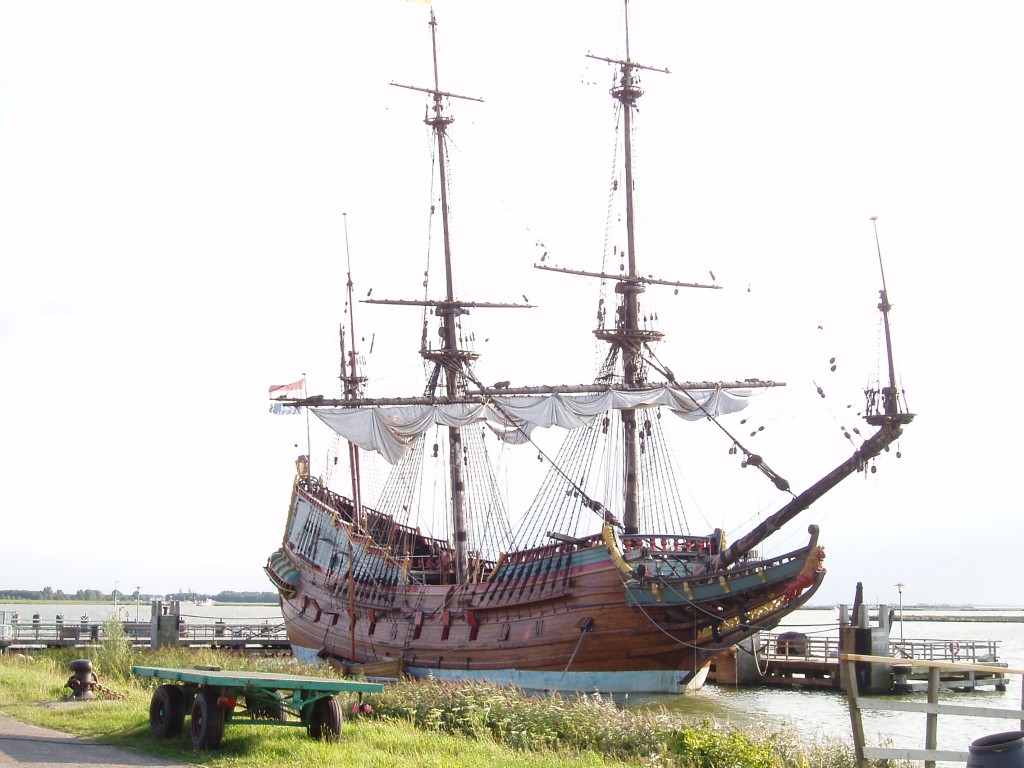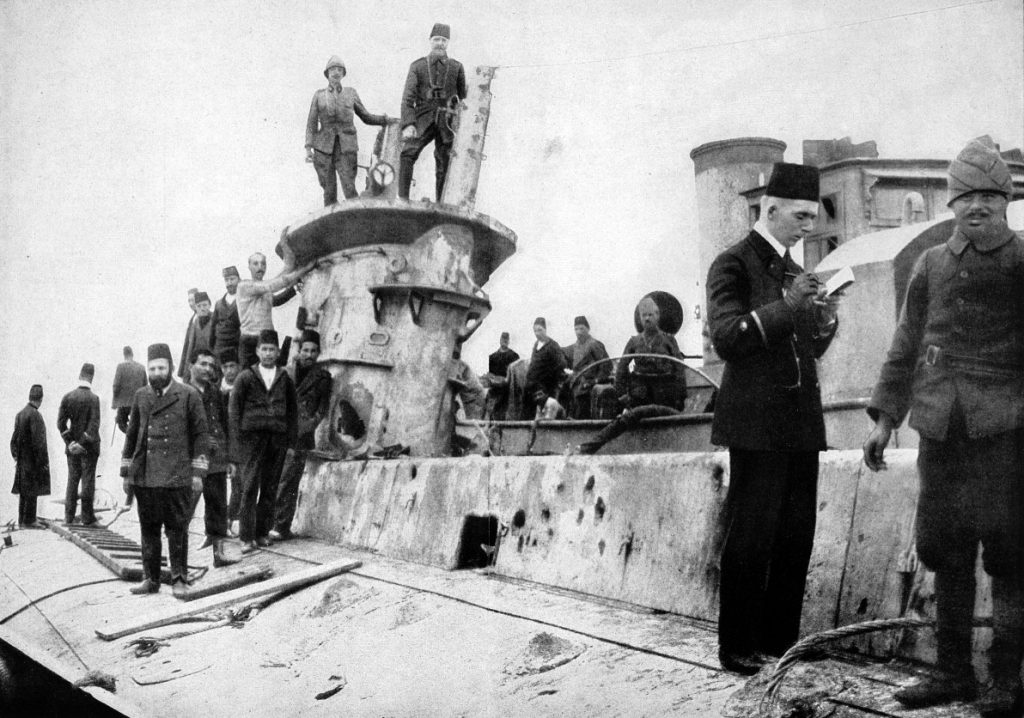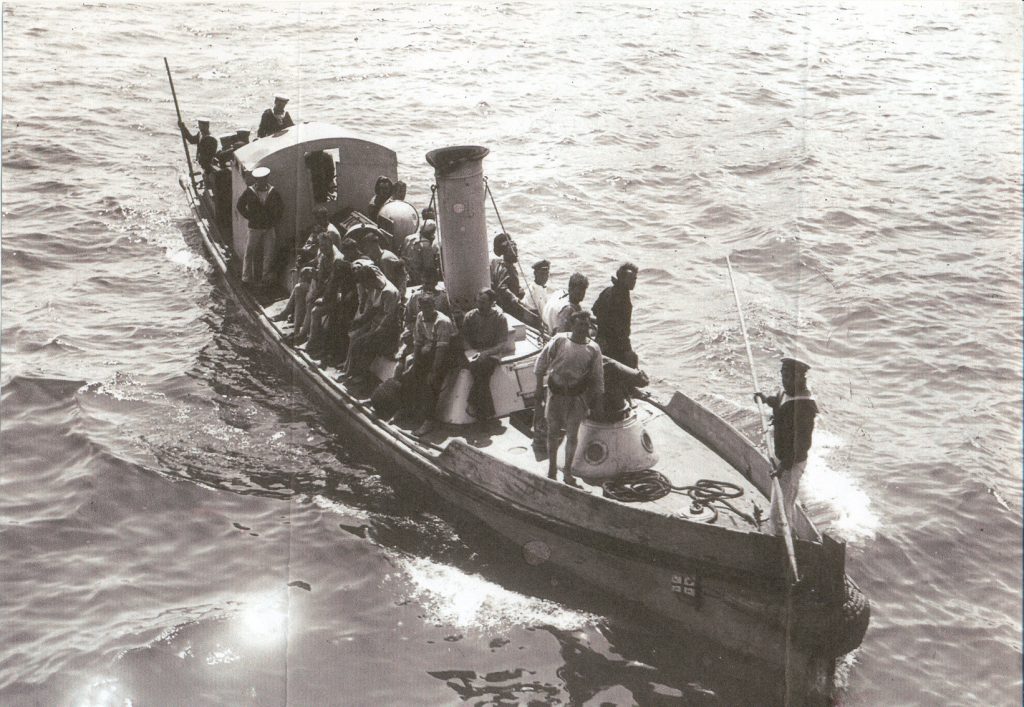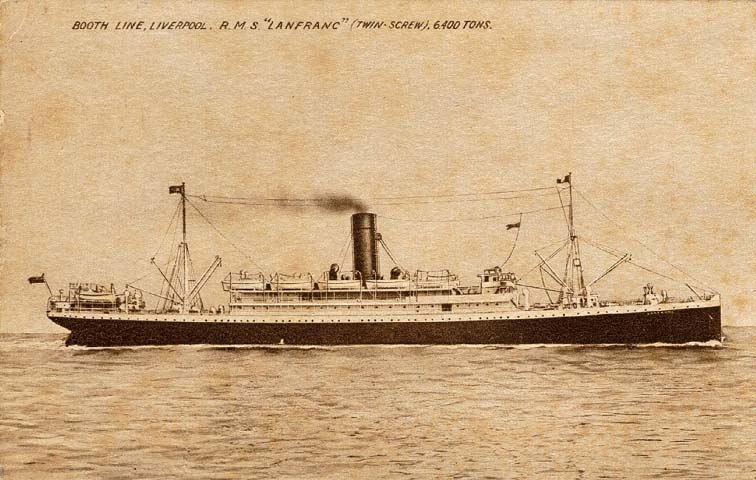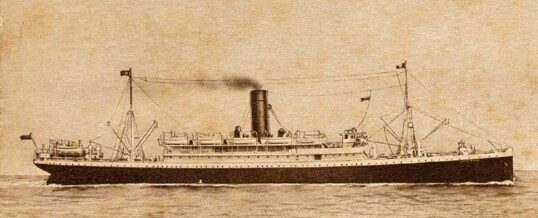
TREASURE FIRED FROM CANNONS: The 17th day of April has seen many thousands of shipwrecks. In 1617, a Dutch “pirate” ship, which had run out of cannon balls, loaded its heavy guns with stolen gold and silver to fire into the attacking Spanish fleet. And then there is the question of whether the Dutch freighter Sembilan was carrying Iranian gold pahlevis and British gold sovereigns when she was torpedoed during World War II. This is part of my series “Today’s™ Shipwrecks™. If you are seeing this in a post, other than on Shipwrecks.com, and you want to read more about these and other ships lost on an April 17 go to http://shipwrecks.com/shipwrecks-of-april-17/
Today’s Shipwrecks™
April 17
compiled and edited by Dr. E. Lee Spence
1617: In April of 1617, a Spanish fleet, commanded by Don Juan Ronquillo, sought out and fought a Dutch fleet of six ships, commanded by Admiral Joris van Spilbergen, of the Dutch East India Company, consisting of the flagship Nieuwe Zon Van Holland (New Sun of Holland), which was also called the Grote Zon (Great Sun); the Zwate Leeuw (Black Lion); the Gallyassee; the frigate Ter Veere (To Veer); the Grote Aeolus (Great Aeolus); and at least one other, which had been raiding Spain’s trade in gold, spices, porcelain, etc. with China, and which had captured and looted a fleet of 25 to 35 Chinese junks of its riches. The Spanish rightly considered the Dutch to be pirates. The Spanish fleet, which included Ronquillo’s 50-gun flagship, the galleon Salvador (claimed by Spain to be the mightiest warship ever to roam the seas); the San Juan Baptista, commanded by Admiral Pedro de Heredia; the San Miguel commanded by Admiral Rodrigonde Vilastigui; the Nuestra Senora de Guadalupe, commanded by Juan Bautista de Molina; the San Lorenco, commanded by Captain Azevedo; and the almiranta San Marcos, commanded by Don Juan de la Vega. Numerous smaller, though heavily armed galleons and about twenty rowing galleys, staffed with battle-hardened soldiers, also made up the Spanish fleet.
The Spanish found the Dutch fleet off Honda Bay, Zambales, Philippines, on the 14th and a series of engagements continued through the 17th. In the fighting (afterwards known as the Battle of Manila), the Dutch flagship and two of the larger ships were sunk. Aboard the Dutch flagship was Jonathan Derickson Lamb, commanding officer of the Dutch Squadron, and with him was the bulk of the treasure the Dutch had looted from the fleet of junks and even more treasure pillaged from ships captured along the coast of India. The rest of the Dutch fleet escaped to Japan. Spilbergen was among the survivors and returned to Holland where he wrote about his exploits. The Spanish later claimed that during battle the Dutch, who had allegedly run out of lead and iron shot, had loaded their guns with gold and silver coins, which they fired into the Spanish fleet.
In a subsequent battle, with the Dutch ships Rode Leeuw (Red Lion), Vlissingen (Flushing), which had not been in the Battle of Manila, the San Marcos, grounded on a reef and was torched to prevent her from falling into the hands of the Dutch. Second only to the Salvador, the San Marcos mounted 36 bronze cannons, some of which were afterwards salvaged by the Spanish.
On learning the following year (1618) that six ships of the Spanish fleet, including the mighty Salvador, had been sunk in a Typhoon, the Dutch returned to the Philippines to resume their attacks on the rich Chinese junks and Spanish ships that sailed through those waters.
1701: The HMS Asia (ex-Asia Merchant), 89 men, was wrecked on April 17, 1701. Its not clear if she was scuttled or merely foundered. There is also some confusion as to her location. Some people give it as in the Bay of Bulls, Newfoundland, others in a bay with a similar name near Cadiz, Spain. In any case, she was 460 tons and had been built in 1683 for Gregory Page, and the following year was taken into the East Indies trade, but finished in that service in 1685. In 1694 she was purchased by the British admiralty. She had 32 guns.
1801: This appears to have taken place in the middle April, so I am including it here. Although this ship was gotten off, her guns and shot were lost. A letter from an officer of His British Majesty’s frigate Cleopatra, Captain Israel Pellew, stated: “we just arrived here from a long cruise, and I am sorry to say, an unfortunate one. We were on shore of the island of Abaco, one of the Bahamas, three days and three nights, and very nearly lost, but thank God and perseverance, we got her off again, having been obliged to heave all of our guns and shot, and even part of our ballast overboard, lost our false keel, and hurt the ship’s bottom a little.” (Note by ELS: This is one reason that even when you find cannons, shot and ballast or other artifacts on the bottom, you shouldn’t automatically conclude that you have discovered a shipwreck.)
1780: The British transport Blandford, was wrecked on the Shingle Bank (probably Chesil Beach in Dorset, southern England) on April 17, 1780. She had a cargo of copper and tin ingots.
1803: A small sailing boat was upset and sunk off Castle Pinckney in Charleston Harbor, South Carolina, on April 17, 1803. Captain Geyer, who was the master of a schooner, and his wife, with three sailors were in the boat when it sank. All were rescued by some fishermen, and Mrs. Geyer was credited with saving her husband as he could not swim and she held his head out of water until help arrived.
1803: A boat carrying Mr. Thomas Dewees; Mr. A. Howard; and some other young men out on a pleasure cruise, was upset by a “flaw of wind” off Town Creek in the Cooper River, Charleston, South Carolina, on April 17, 1803. Thomas Dewees was drowned while attempting to swim for shore. The others were saved.
1852: The British bark Thomas King, Captain J. Walker, bound from Sydney, Australia, for Manila, Philippines, with 3,500 British pounds Sterling in coin and £8,000 in gold dust, ran aground off Cato Reef in the Coral Sea on April 17, 1852, and became total wreck. Three died in the wreck. Two boats, one with her captain set out for help. But, after making shore at Double Island Bay, they were hunted down and all killed except for the captain and one seaman. Two weeks after the wreck, the survivors who had been left on the reef were rescued by the whaler Lady Blackwood. The Thomas King was built in London in 1826 and was owned by King and Company. She was 346 tons. She was classed AE-1 by Lloyds and was sheathed with felt and yellow metal in 1849.
1864: The Confederate States ironclad Jackson (a.k.a. Muscogee) was captured and burned by the Federal troops in the Chattahoochee River at the Columbus Navy Yard at Columbus, Georgia, on April 17, 1865. The troops were a wing of General Sherman’s army and were under the command of General James H. Wilson. The Jackson is variously reported as a propeller steamer and as having a “center wheel,” due to her having been altered from a paddle wheel to a twin screw system. The ironclad was armed with four 7″ Brooke rifles and two 6.4″ Brooke rifles, she may have also carried one or two 12-pounder boat howitzers. She had two horizontal, direct-acting, high-pressure engines and four boilers. Her machinery was manufactured by the Confederate States Naval Iron Works at Columbus.
According to Robert Holcombe, curator of the Confederate Naval Museum, the wreck was located in 1960. It was raised in 1963 and is now on display at the James W. Woodruff, Jr., Confederate Naval Museum at Columbus, Georgia.
1887: The British passenger/freight steamer Tasmania, was proceeding at full speed, making from 12 1/2 to 13 knots, even though the weather had been dark and threatening, with the wind blowing a fresh breeze from about S.W., with a beam sea. About four minutes after 4, the morning of April 17, 1887, breakers were reported by the look-out man from forward, and almost immediately afterwards the vessel struck, at first slightly, and then more heavily, on the Monachi Rocks, South Corsica, some 50 yards inside the beacon, and became fast. Orders were thereupon given to stop the engines, which was done, and in about 3 or 4 minutes afterwards the captain, who had then come on deck, directed the engines to be put full speed astern; but finding that she was making water in all the compartments, and that she would probably sink if she came off the rocks, the engines were stopped, and orders were given to get out the boats. Three out of the four boats on the port side were smashed against the ship’s side, one only, the third boat, having got afloat. Of the four boats on the starboard side the aftermost was smashed, but the first three were go out under circumstances to be hereafter stated, and succeeded in landing all the women and children except two ladies, who preferred to remain on board with their husbands. During the night of the 17th the sea continued to break over the vessel, and as many as could do so took refuge in the smoking room, which was however constantly flooded with water, the windows on the port side having been broken. At daylight a good many of the natives were found to have died either on the decks or in the rigging; and shortly afterwards a steam yacht called the Norseman came alongside, followed soon afterwards by a French steamer, and succeeded in taking off the survivors from the wreck and conveying them to Ajaccio. Why none of the lifeboats returned to the ship during the 17th was afterwards a matter of debate; but at daylight of the 18th one lifeboat returned, the wind and sea having by that time considerably gone down, and succeeded in conveying some of the passengers from the wreck to the steamers, after which the lifeboat was towed round to Ajaccio.
The Tasmania had left Bombay on the 1st of April, bound for London, via Marseilles, France, with 144 passengers, the mails, and a general cargo, and having on board a crew of 161 hands, of whom 55 were Europeans and 106 natives.
The result of this unfortunate shipwreck was that a very valuable vessel, worth (at the time), about £120,000, together with her very valuable cargo and effects on board, was almost totally lost, and that the master, the fifth officer, a quartermaster and 32 natives, making up a total of 35 souls, perished.
The Tasmania was a screw steamer of 4,488 gross tons and 2,654 net tons. She was built in 1884 by Caird & Company, Greenock, and was at the time of her loss was the property of the Peninsular and Oriental Steam Navigation Company, No. 122, Leadenhall Street, in the City of London, Mr. Henry Bayley being the managing director. She was powered by a compound, two-cylinder, inverted horsepower steam engine of 800 horsepower. For a picture of her see clydesite.co.uk.
1915: Early in the morning of April 17, 1915, the E-class, British Royal Navy submarine E15, commanded by Lieut. Commander Theodore S. Brodie, was run aground in 26 feet of water, directly under the guns of Fort Dardanos, Kephez Point, south of Çanakkale, Straits of the Dardanelles. E15 was quickly fired upon by the fort and disabled. Lieut. Commander Brodie was in the conning tower and was struck and killed by shrapnel. Six of the crew were killed by chlorine gas released when E15’s batteries were exposed to seawater. Forced to evacuate, the remaining crew surrendered and were later incarcerated in a POW camp near Istanbul, where six of them died. The bodies of Lieut. Commander Brodie and several crew, initially buried on a nearby beach, were later reinterred at the Chanak Consular Cemetery.
The stranded British submarine was soon spotted by the Royal Naval Air Service (RNAS), and reported to the SS Hindu Kush, the Allied submarines’ HQ and depot ship. It was considered imperative that the E15 be destroyed to prevent the German’s and the Turks from salvaging her. Finally, on the night of 18 April, two 17 metre picket boats, one from Triumph, the other from Majestic, both armed with two 14-inch diameter torpedoes, went in. Lieutenant Commander Eric Robinson, a volunteer from Vengeance, commanded the expedition from Triumph’s boat; Lieutenant Claud Herbert Godwin skippered the boat from Majestic. The two vessels managed to navigate the narrow channel for seven miles before being detected and illuminated by searchlights, attracting a hail of fire from both shores. Both boats remained unscathed, but unsure where to go, until a Turkish searchlight briefly illuminated the stricken submarine. Godwin seized his chance. Blinded by the lights, his first shot missed, and seconds afterwards the Turkish gunners scored their only hit, blowing away part of the stern and mortally wounding one seaman. Undeterred, Godwin went in again and fired his second torpedo, which struck E15 just forward of the conning tower, but well below the waterline. Robinson, observing his comrades’ plight, and despite being under heavy fire, unhesitatingly brought his boat alongside and rescued them. Now doubly laden, Triumph’s boat fled downstream unobserved, while the Turkish gunners concentrated their fire power on the drifting and (unknown to them) abandoned remains of her sister ship.
The E15 action would no doubt have earned Robinson the Victoria Cross had he not already been recommended for the award following earlier exploits on the Gallipoli peninsula. Instead, he was promoted to Commander by special decree. Lieutenant Godwin was awarded the DSO, Lt. Brooke-Webb and Midshipman Woolley received the DSC, while the rest of the crews, all volunteers, received the DSM.
1917: On the evening of April 17, 1917, His British Majesty’s Hospital Ship Lanfranc, while transporting wounded from Le Havre, France, to the port of Southampton in the central part of the south coast of England, was torpedoed without warning by German submarine UB-40, commanded by Hans Howaldt, when she was 42 (or 4) miles North 1/2 East of Le Havre. Some accounts show only 34 lives lost, while others show 22 British and 18 German patients died. 570 survivors were picked up by the destroyers HMS Badger and HMS Jackal aided by HMS P-47 and the French patrol boat Roitelet, and taken to Portsmouth.
The twin screw steamer was the former Royal Mail Steamer Lanfranc, built by the Caledon Shipbuilding & Engineering Company in Dundee, Scotland, and launched in 1906. She was 6,287 gross tons, 418.5 feet in length, 52.3 feet in breadth, and 27.2 feet in depth of hold. Converted to a hospital ship in 1915, the Lanfranc had accommodations for 403 wounded.
1918: The Imperial German submarine UB-82 was sunk on April 17, 1918, in latitude at 55°14′ North, longitude 5°55?W, by British warships HMS Pilot Me and HMS Young Fred. The death toll was reported as 37 men, which would have been UB-82’s entire crew. UB-82 was 516 tons, and measured 183 feet 3 inches in overall length and 19 feet in breadth. She was armed with one 3.46-inch (8.8 cm) deck gun; and five 19.7-inch (50 cm) torpedo tubes, which were mounted four in her bow, and one in her stern, and carried ten torpedoes.
1943: On April 17, 1943, the Dutch freighter Sembilan, bound from Glasgow, Scotland, for Egypt, via Durba, with munitions was torpedoed and sunk off South Africa, in latitude 31°30′ south, longitude 33°30′ east, by the Italian submarine Da Vinci. Of her 86 crew and officers, only 1 Lascar sailor survived. The SS Sembilan was built in 1922 and was 6,633 tons. Her official number was 5605649 and her signal letters were PHLH. (Note by ELS: There is reason to believe that the Sembilan was involved in the shipment of Iranian gold pahlevis coins and British gold sovereigns to Tehran, Iran, when she was lost.)
• • •
NOTE: This is by no means meant to be a complete list of the vessels lost on April 17, as there have been thousands of ships lost for every day of the year. All of the above entries have been edited (shortened) and come from various editions of Spence’s List™. The original lists usually give additional data and sources. Those lists are being updated and are or will be made available for a fee elsewhere on this site.
© 2013, 2017, 2018, by Dr. E. Lee Spence for composition, content and compilation.
Share